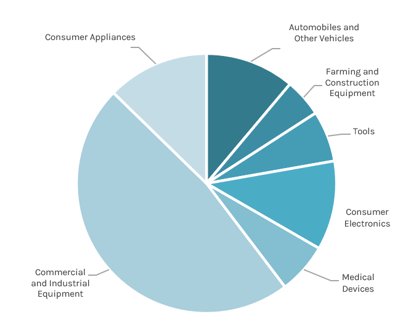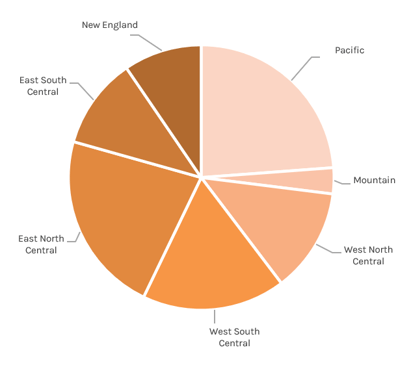Product Strategy: The Results are in
 By
Maziar Adl
·
6 minute read
By
Maziar Adl
·
6 minute read
In the Spring of 2022, we surveyed a group of product manufacturers across the United States to learn more about how companies implement their product strategies, gauge their satisfaction with their methods, and learn more about which tools they use.
The results were surprising, revealing several key areas of opportunity that any product manufacturer can learn and take inspiration from.
Who Are We?
Gocious is a SaaS company that provides manufacturers and product-based companies a platform to manage their roadmaps and better align their product strategy with their business goals. We seek out the gaps and opportunities in existing tools to create solutions that increase transparency, agility, and effective collaboration within manufacturing companies.
Why Did We Create This Survey?
We're always looking for ways to create better services and features for our manufacturing customers. We wanted to get to the source of how manufacturing companies in the United States integrate their business goals into their product strategies.
We also wanted to know what tools manufacturers are currently using and whether or not they are satisfied with them.
Survey Methodology
Before we dig into the fascinating results, let's first lay out our methodology and highlight the survey participants.

We sent a survey to 200 manufacturers, of which 80% of them were product manufacturers. Of those product manufacturers, there was varied representation amongst industries, including the following:
- Automobiles and Other Vehicles (7%)
- Farming and Construction Equipment (3%)
- Tools (4%)
- Consumer Electronics (7%)
- Medical Devices (4%)
- Commercial and Industrial Equipment (30%)
- Consumer Appliances (8%)

The respondents of the survey represented every region of the United States, categorized as follows:
- Pacific (15%)
- Mountain (2%)
- West North Central (8%)
- West South Central (11%)
- East North Central (14%)
- East South Central (7%)
- New England (6%)
- Middle Atlantic (17%)
- South Atlantic (20%)
Of the survey respondents, the gender balance was almost entirely even, with 53% male and 47% female.
The age balance was also fairly distributed, with 6% between the ages of 18 and 19, 39% between the ages of 30 and 44, 34% between the ages of 45 and 60, and 20% over the age of 60.
Now that we've identified who participated in our survey, let's take a look behind the scenes. The results show us how manufacturers manage their roadmaps and align their product strategies to their business goals—or long to do so.
Product Strategy Questions
The survey began by clarifying each company's product strategy and the effectiveness of its business goals.
Do You Have a Multi-Year Product Strategy?
Product manufacturing requires long-term planning, which means that multi-year product strategies are essential. Yet, when we asked whether or not our participants had a multi-year product strategy, only 78% replied "yes," while 22% said "no."
Do you have a multi-year product strategy?

Who Owns the Product Strategy in Your Company?
This question generated some interesting answers. Examine the responses below and consider how you'd answer this question for your company.
- Executive Leadership (50%)
- Product Management (20%)
- Project Management (10%)
- Marketing (6%)
- Sales (5%)
- Engineering (5%)
- Other (3%)
- Finance (1%)
TakeawayWhile it may be natural for executive leadership to be heavily involved in creating the product strategy, the more departments that buy into it, the stronger the follow-through will be. With the right tools, there is an opportunity to see product management take greater ownership of the company's product strategy and communicate that strategy to the other stakeholders. |
Tells Us About Your Business Goals
The following questions touched on each company's business goals, whether they achieved their 2021 goals, what percentage of their goals were met, and whether or not the respondent felt the company's business goals aligned with the product strategy.
Did you meet your business goals in 2021?

What percentage of your goals did you meet in 2021?

Is your product strategy aligned with your overall business goals?

How effective do you feel your product strategy is at delivering on business goals?

Takeaway #1Interestingly, 96.5% of respondents stated their product strategy aligned with their business goals, but only 73% felt confident that their strategy was delivering on the goals. This tells us that there is a gap between aligning strategy to goals and managing that strategy to achieve the goals. |
Takeaway #2Another curious insight was how 76% of respondents claimed their company met its 2021 business goals. Yet, when given the opportunity to give a percentage range of how many goals were achieved, the average answer was only 76%. There is an opportunity here to increase the number of business goals achieved yearly, which goes hand-in-hand with managing product strategy more effectively. |
Alignment With Business Goals
In the next section of the survey, we asked a series of questions about which tools companies use to communicate their product strategy and manage their roadmaps.
Overall, do you feel you have an effective product strategy to meet your business goals?

Do you wish you had a better alignment of your product strategy with your business goals?

TakeawayEven though 80% of respondents stated they were satisfied with their product strategy's effectiveness in meeting business goals, 57% of respondents still answered that they wished they had a better alignment of their product strategy to their business goals. This tells us that while there is a general sense of satisfaction with business goal achievement, there is a certain amount of settling for the status quo. When prompted, half of the respondents knew their company could perform better. |
Communication Tools
In this next section, we asked a series of questions related to the themes of communication, collaboration, and the tools used to manage stakeholders.
Do your teams know the product strategy and business goals?
When asked about whether or not their teams knew the company product strategy or business goals, the respondents gave the following answers:

Do your teams collaborate on product strategy?

Do you have a scorecard or dashboard to track the progress of your product strategy and get real-time updates?

What tool(s) do you use to manage your product strategy?
 When we asked participants which type of tool or tools they are using to manage their product strategies, they responded as follows:
When we asked participants which type of tool or tools they are using to manage their product strategies, they responded as follows:
- Office Suite (Microsoft or Google) - 64%
- Innovation Management Systems - 37%
- Product Roadmap Tool (Aha, Product Plan, Other) - 32%
- Internally Developed System - 32%
- Extensions of PLM System - 11%
- Other (4%)
Takeaway #1Surprisingly, only 75% of respondents felt their teams knew their company's business strategy. It was even more astonishing to learn that only 66% of respondents felt their teams knew their business goals. This reveals a huge opportunity to improve communication and collaboration. |
Takeaway #2Companies are struggling to communicate their business goals and align their product strategy to their goals. A key area of opportunity lies in the software and tools they are using. Without software to connect stakeholders and track progress, it's impossible to ensure all team members follow the strategy to meet the business goals. |
Takeaway #3With only 32% of respondents saying they are using a product roadmapping tool, there is a huge gap in the market to provide better tools. Better software can not only helps create and manage roadmaps, but coordinate collaboration, facilitate real-time communication, and provide a single source of truth for all stakeholders.
|
Meetings and Collaborations
How often do you have product strategy meetings?
 When asked about how often their company held product strategy meetings, the respondents stated the following:
When asked about how often their company held product strategy meetings, the respondents stated the following:
- Monthly (51%)
- Quarterly (25%)
- Every six months (10%)
- Annually (3%)
- Other (11.5%)
Who attends product strategy meetings?
Knowing who actually attends the product strategy meetings is an important detail to note. We asked the participants, and they said this:

How do you decide which strategic items get worked on?
Based on the answers earlier on in the survey when asked "Who owns the product strategy?" the following responses make sense:

Takeaway #1There is a significant opportunity for manufacturers to plan cross-functional meetings that involve more meaningful input from stakeholders.
|
Takeaway #2Just over half of respondents hold monthly product strategy meetings. This reveals an opportunity for companies to hold less frequent strategy meetings by encouraging team buy-in to the product strategy to meet business goals. Companies can achieve this with straightforward communication tools and effective collaboration processes. |
Possibilities and Solutions
Our 2021 Product Strategy Survey highlight some key trends across the manufacturing sector of the United States:
- There is an opportunity to create a better alignment between product strategy and business goals.
- There is a need to develop better tools to help manufacturers track and communicate their strategies and goals.
- Companies need to prioritize better inter-departmental communication and collaboration.
A New Approach to Roadmapping
In order to effectively meet long-term business goals, manufacturing companies need to have multi-year roadmaps to align their product strategies to meet those goals. One logistical shortcoming is that most companies aren't using the right tools to support their efforts. Our survey revealed that out of the manufacturers who don't use multi-year plans, only 40% of them achieved business goals in 2021. That leaves 60% of companies not hitting their goals and not using multi-year plans.

One of the primary reasons why manufacturing companies fail to make multi-year plans is not having the right tool to effectively roadmap their product portfolios over three, five, and ten or more years. With the right roadmap management tool, companies can map out their long-term plans and create better alignment between strategy and goal.
The Importance of Cross-Functional Teams and Collaboration
Just over half of our survey participants told us they hold monthly product strategy meetings. This begs the question of whether those companies truly have alignment and buy-in for their strategy or if they are reworking their plan each month.

Companies that prioritize cross-functional teams when managing their roadmaps, along with powerful tools that enable communication across the organization, meet less often. Quarterly meetings are sufficient because each department understands the business goals, knows the product strategy, can monitor and track roadmap progress, and can contact other stakeholders in between meetings.
How the Right Tool Can Make a Difference
One of the statistics of our survey that jumped off the page was the fact that 63% of the industry is still using an Office Suite to manage their product strategy and roadmap.
Another point of clarity was that 80% of respondents felt they have an effective product strategy, but only 55% have a means of tracking their progress. This means that 25% of those who think they have an effective strategy are just guessing. No one in business wants to rely on guesswork when striving to achieve business goals.
There are great roadmapping tools out there. However, one specific tool was designed for manufacturers to manage large product portfolios over short, medium, and long periods. That product is Gocious PRM Software.
The Gocious Solution to Product Roadmap Management
Gocious product roadmap management (PRM) Software is a user-friendly, visually sleek, powerful roadmap management tool. Entire productA portfolios can be mapped out, analyzed, and compared for greater flexibility and agility between markets and demand. Global teams can share access to one source of truth for greater transparency, faster communication, and efficient decision-making and collaboration.
We conducted this survey to showcase the opportunities in the industry and to offer a powerful solution to product strategy alignment. Book your free demo to see how Gocious software can work for your company.
